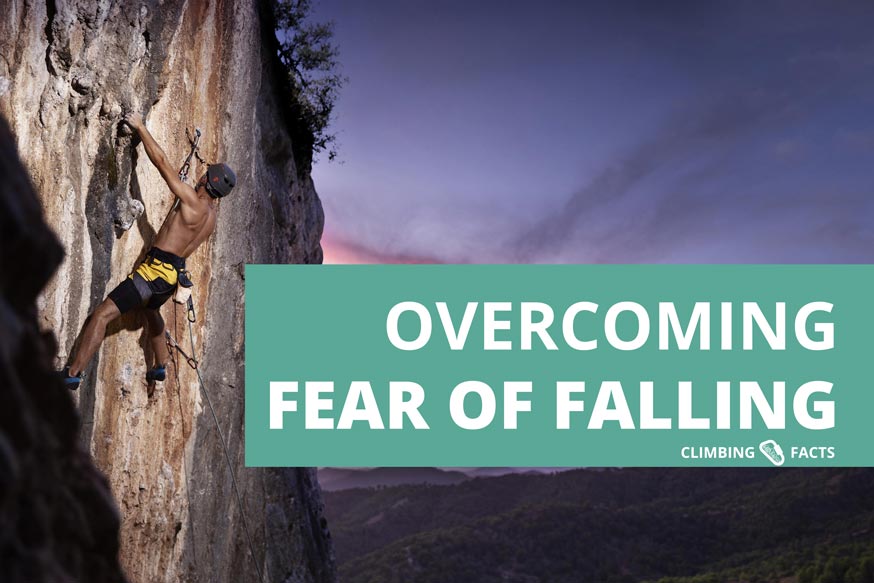Fear of falling is one of the greatest obstacles in climbing. Holding back all types of climbers: trad climbers, sport climbers, and boulders. Being afraid to take a big whipper can prevent you from sending your project, reaching your goal grades, and limits you in more ways than you may think.
Fear of Falling is real, and the only way to get passed it is by acknowledging your fear and doing something about it.
This article is for all those who recognize fear of falling may be holding them back, and contains exercises you can use to push past it and finally get over your fear of falling.
Tips to Conquer Fear of Falling
Start taking practice falls
To ease your way into overcoming your fear of falling, you need to get used to taking falls. Climbing experience helps, but actively taking practice falls will accelerate the process. Start incorporating falling practice into your training sessions. Begin small, falling on toprope and gradually work your way up to falling from clipping distance.
It’s scary to force yourself to take falls, but it will pay dividends to your climbing ability.
In his book, 9 out of 10 climbers, Dave Macleod says the following: ‘The hardest training session in falling confidence is the first one, and if more training is carefully applied, each session will be easier than the last.’
Take a couple of practice falls before every climbing session and you’ll notice yourself getting more and more comfortable.
And don’t just stop at the gym, to truly get comfortable with falling, you need to do it on real rock. Inside comfort does not equal outside comfort.
Don’t just stop at the gym, you also need to practice falling on real rock. Just because you’re comfortable inside, doesn’t mean you’ll take that level of comfort outdoors as well. Doing practice falls on real rock is something most climbers have to do each year when the season starts to regain confidence in their falling ability.
Retrain your mind
Falling feels wrong, and that makes it so scary. It’s normal to panic when taking an unexpected whipper. However, this ‘wrong feeling’ can be reprogrammed. It will likely never fully go away, but the more you practice your falls, the more you get used to the idea of falling.
It’s unlikely you’ll feel a big difference after a single session of falling practice. Even if you get more comfortable with falling ‘on purpose’ there is still a difference between deliberate fals and unexpected ones. So long as you aren’t fully comfortable with the latter, you’ll find yourself stuck sending climbs within your comfort zone, and panicking whenever you go beyond.
In order to retrain our mind, we need to take practice falls often, during many different sessions, from different heights and in different situations.
Notice when you get scared

Oftentimes we find ourselves stuck on a crux and blame the wrong thing for not sending. ‘My fingers aren’t strong enough’, ‘I don’t have enough reach’, the list goes on. Oftentimes, the issue isn’t reach, or strength, it’s fear.
Returning from an ankle injury, I thought I had lost a lot of strength and endurance. I had anticipated a decline in performance, but the difference was much bigger than expected. Do I just suck now?
I soon realized the issue wasn’t strength or endurance, I was simply afraid of putting weight on my right ankle. Forcing myself into inefficient positions. After this realization, I knew that I wouldn’t get back to my pre-injury level until I could fully trust my ankle again. So I dealt with the fear, slowly pushing myself to put more and more weight on my ankle.
Using the exact same approach I tell climbers to deal with fear of falling, I dealt with my fear slowly by pushing myself to put more and more weight on my ankle.
We can’t perform when we’re scared. If we’re afraid to fall, we’re going to overgrip every hold, wasting a ton of energy. We’ll avoid risky positions out of fear. We won’t push ourselves. We’ll be tired and feel tired more quickly.
Acknowledge your fear. Notice how and when it’s holding you back. Every time something doesn’t work, ask yourself if fear could have something to do with it. It’s very often the case.
Only by noticing your fear, can you work on it. And soon you won’t be overgripping, or pushing yourself into more favorable yet inefficient positions.
While pushing boundaries is always scary, as climbers, we need to be just comfortable enough to trust our grip, trust our feet, and trust our technique.
Content to help you overcome Fear of Falling
Consuming content is a great add-on to climbing training. I truly believe you can become a better climber by watching others climb on YouTube or by reading climbing-related books. So in this portion of the article, I’ll be recommending some of my favorite sources that mention the fear of falling and help you tackle it.
9 Out of 10 Climbers Make the Same Mistakes
One of my favorite climbing books, 9 out of 10 climbers make the same mistakes by Dave Macleod (quoted earlier) has a phenomenal chapter on fear of falling and how to overcome it.
If you aren’t familiar with this Scottish climbing legend, he has a youtube channel that also contains a ton of valuable free information, some of which focuses on fear.
For my fellow climbers who like a good climbing book full of tips and anecdotes, 9 out of 10 climbers is chefs kiss.
Fear of Falling Series by Hard is Easy
Here’s a great video series by Hard is Easy in which he documents Hannah’s process in overcoming her own Fear of Falling while transitioning from indoor holds to outdoor rock. The entire playlist contains 7 videos of some of the highest-quality climbing content YouTube has to offer. Add it to your ‘watch later’, and you will not be disappointed.
Final Thoughts
You are not alone in your quest to overcome the fear of falling. Every climber goes through it, and the fear never really goes away either. It needs to be maintained, if you stop taking whippers, it will come back.
